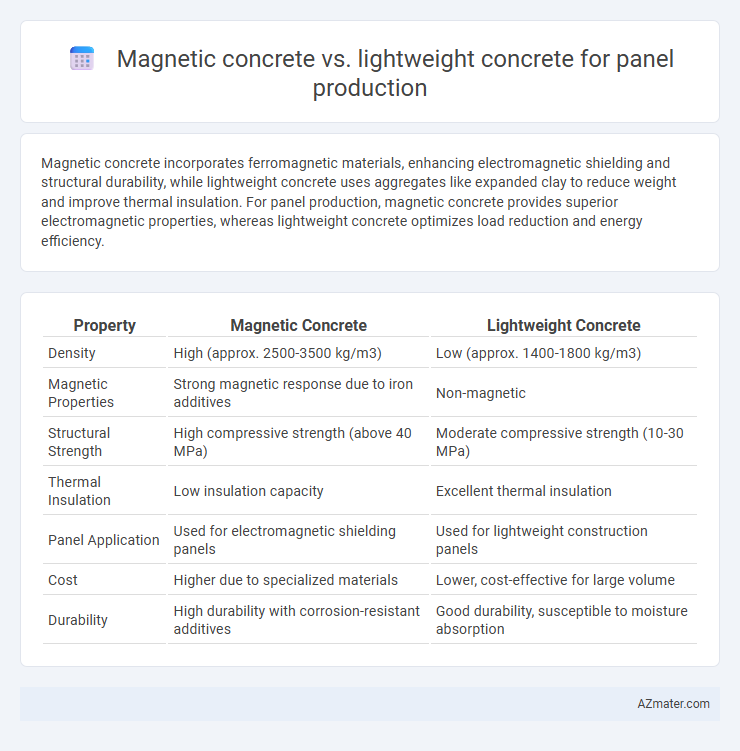Magnetic concrete incorporates ferromagnetic materials, enhancing electromagnetic shielding and structural durability, while lightweight concrete uses aggregates like expanded clay to reduce weight and improve thermal insulation. For panel production, magnetic concrete provides superior electromagnetic properties, whereas lightweight concrete optimizes load reduction and energy efficiency.
Table of Comparison
| Property | Magnetic Concrete | Lightweight Concrete |
|---|---|---|
| Density | High (approx. 2500-3500 kg/m3) | Low (approx. 1400-1800 kg/m3) |
| Magnetic Properties | Strong magnetic response due to iron additives | Non-magnetic |
| Structural Strength | High compressive strength (above 40 MPa) | Moderate compressive strength (10-30 MPa) |
| Thermal Insulation | Low insulation capacity | Excellent thermal insulation |
| Panel Application | Used for electromagnetic shielding panels | Used for lightweight construction panels |
| Cost | Higher due to specialized materials | Lower, cost-effective for large volume |
| Durability | High durability with corrosion-resistant additives | Good durability, susceptible to moisture absorption |
Introduction to Magnetic and Lightweight Concrete
Magnetic concrete incorporates ferromagnetic materials, enhancing electromagnetic properties ideal for structural health monitoring and electromagnetic shielding in panel production. Lightweight concrete, composed of low-density aggregates such as expanded clay or shale, offers reduced weight and improved thermal insulation, making it favorable for energy-efficient building panels. Both concretes serve specialized applications, with magnetic concrete focusing on functionality through magnetic responsiveness and lightweight concrete emphasizing material economy and thermal performance.
Core Differences in Material Composition
Magnetic concrete incorporates ferromagnetic materials such as iron filings or steel fibers, enhancing its magnetic responsiveness and structural integrity. Lightweight concrete primarily utilizes porous aggregates like expanded clay, perlite, or pumice to reduce density and improve thermal insulation. The core difference lies in their composition: magnetic concrete is designed for magnetic functionality and strength, while lightweight concrete focuses on reducing weight and enhancing insulation properties.
Manufacturing Processes Compared
Magnetic concrete manufacturing involves integrating ferromagnetic materials such as iron powder or magnetite into the mix, requiring precise handling to maintain magnetic properties and uniform distribution, often demanding specialized mixing equipment. Lightweight concrete production incorporates lightweight aggregates like expanded clay, shale, or pumice, which necessitate controlled water absorption and mixing techniques to achieve optimal density and strength. Both processes focus on balancing material properties to meet specific panel performance criteria, but magnetic concrete demands additional steps for retaining magnetic functionality during curing.
Mechanical Strength and Durability
Magnetic concrete exhibits higher mechanical strength due to the incorporation of ferromagnetic materials like iron particles, enhancing load-bearing capacity and tensile strength compared to lightweight concrete. Lightweight concrete, typically composed of aerated aggregates or expanded polystyrene, offers reduced density but generally lower compressive strength, impacting its suitability for high-stress applications. Durability in magnetic concrete is improved by its resistance to crack propagation and corrosion shielding effects of embedded magnetic materials, whereas lightweight concrete may experience reduced durability under freeze-thaw cycles and chemical exposure due to its porous structure.
Weight and Structural Implications
Magnetic concrete typically exhibits higher density due to embedded ferromagnetic materials, resulting in increased weight compared to lightweight concrete, which incorporates aggregates like expanded clay or polystyrene beads to significantly reduce mass. The increased weight of magnetic concrete improves structural strength and durability, making it suitable for applications requiring enhanced load-bearing capacity and electromagnetic shielding. Lightweight concrete offers advantages in seismic resilience and ease of handling, but may require additional reinforcement to match the structural demands addressed more directly by magnetic concrete panels.
Thermal and Acoustic Insulation Properties
Magnetic concrete exhibits superior thermal insulation due to embedded ferromagnetic particles that enhance heat resistance, making it ideal for energy-efficient panel production. Lightweight concrete offers excellent acoustic insulation by incorporating air pockets that absorb sound waves, reducing noise transmission in building panels. Combining magnetic concrete's thermal efficiency with lightweight concrete's soundproofing capabilities provides a balanced solution for high-performance construction panels.
Environmental Impact and Sustainability
Magnetic concrete incorporates iron particles that enhance recyclability and reduce the carbon footprint by utilizing industrial by-products, making it a more sustainable option compared to traditional materials. Lightweight concrete, often composed of expanded clay or shale aggregates, offers reduced material consumption and improved thermal insulation, which lowers energy use in buildings. Both types contribute to green construction, but magnetic concrete's potential for waste material integration provides a distinct advantage in reducing environmental impact during panel production.
Cost Efficiency in Panel Production
Magnetic concrete typically involves higher material and processing costs due to the inclusion of ferromagnetic additives, which increase the overall expense compared to lightweight concrete. Lightweight concrete, often composed of expanded aggregates or aerated components, offers significant cost savings by reducing transportation and handling expenses through its lower density. For panel production, lightweight concrete provides better cost efficiency by decreasing production time, lowering material costs, and improving energy efficiency during curing.
Common Applications and Industry Usage
Magnetic concrete is predominantly used in infrastructure projects requiring electromagnetic shielding or sensors integration, such as smart roads and industrial flooring, due to its ferro-magnetic particle composition. Lightweight concrete is favored in building construction for panels because of its superior thermal insulation, reduced dead load, and ease of handling, commonly applied in residential and commercial wall panels. Both materials find niche applications, with magnetic concrete targeting advanced technological structures and lightweight concrete serving broader construction needs for energy-efficient and weight-sensitive buildings.
Selecting the Right Concrete for Panel Projects
Magnetic concrete offers enhanced electromagnetic shielding and increased structural density, making it ideal for specialized panel projects requiring durability and magnetic properties. Lightweight concrete provides excellent thermal insulation, reduced load, and easy handling, suitable for projects prioritizing energy efficiency and weight reduction. Selecting the right concrete depends on project-specific requirements such as strength, weight, thermal performance, and electromagnetic properties.

Infographic: Magnetic concrete vs Lightweight concrete for Panel production
 azmater.com
azmater.com